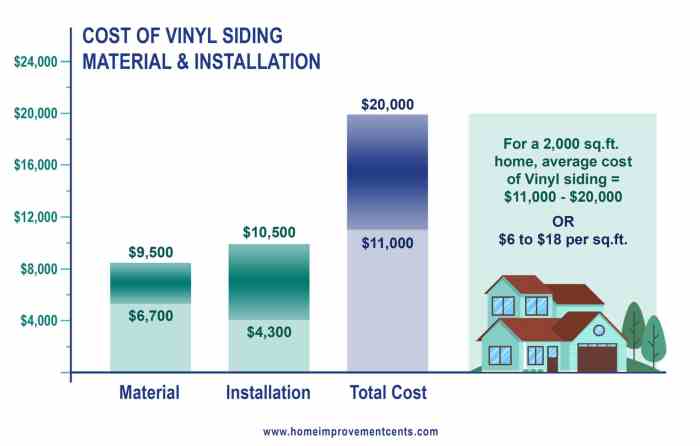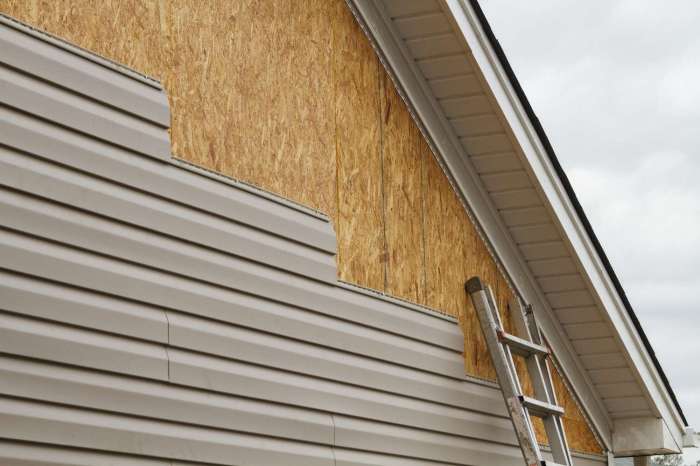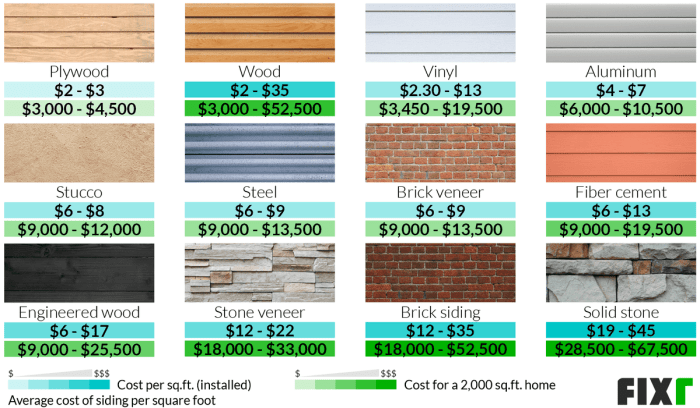Exploring the Average Cost of Siding a House with Vinyl
Diving into the realm of average cost of siding a house with vinyl, this introduction sets the stage for an informative journey that delves into the various aspects of this topic.
Providing insights and analysis, this piece aims to shed light on the complexities surrounding the expenses involved in vinyl siding installation.
Factors influencing the cost of siding a house with vinyl

When considering the cost of siding a house with vinyl, several factors come into play that can significantly impact the overall expense. Understanding these factors is crucial for budgeting and planning purposes.
Quality of Vinyl Siding
The quality of the vinyl siding chosen for a house can have a substantial impact on the total cost. Higher-quality vinyl materials are often more durable, have better insulation properties, and come in a wider range of colors and styles.
While they may cost more upfront, they can result in long-term savings by reducing maintenance and replacement costs.
Size of the House
The size of the house is a direct factor influencing the cost of siding with vinyl. Larger homes require more materials and labor to complete the installation, leading to a higher overall cost compared to smaller houses. Additionally, complex architectural designs or multiple stories can also increase the labor costs associated with siding installation.
Labor Costs
Labor costs play a significant role in determining the total cost of siding a house with vinyl. The expertise and experience of the installation crew, as well as the region's labor rates, can impact the final price. In some cases, hiring a reputable and experienced contractor may cost more initially but can result in a higher-quality installation that lasts longer.
Additional Features and Customizations
Adding extra features or customizations to the vinyl siding project, such as trim work, decorative elements, or unique color combinations, can increase the overall cost. These customizations often require additional materials and labor, contributing to a higher final price compared to a standard siding installation.
Location and Accessibility
The location of the house and its accessibility can also affect the cost of siding with vinyl. Houses located in remote areas or with challenging terrain may require additional time and effort to transport materials and complete the installation, resulting in higher labor costs.
On the other hand, houses with easy access and proximity to suppliers may incur lower transportation and labor expenses.
Maintenance and Warranty
Considering the long-term maintenance and warranty options for vinyl siding is essential when evaluating costs. Higher-quality siding products often come with better warranties and require less maintenance over time, potentially reducing overall expenses in the future. Factoring in these maintenance costs and warranty coverage can help homeowners make informed decisions about the initial investment in vinyl siding.
Average cost breakdown of vinyl siding installation

When it comes to installing vinyl siding on your house, it's important to understand the average cost breakdown to budget accordingly. Here, we will break down the costs into material, labor, additional costs, and total cost to give you a better idea of what to expect.
Material Cost
- On average, the cost of vinyl siding material can range from $2 to $7 per square foot.
- For a typical 1,500 square foot home, the material cost can add up to around $3,000 to $10,500.
Labor Cost
- Labor costs for installing vinyl siding can vary depending on the complexity of the job and location, but it typically ranges from $1 to $3 per square foot.
- For a 1,500 square foot home, labor costs can amount to approximately $1,500 to $4,500.
Additional Costs
- Additional costs may include the removal of old siding, repair of underlying structures, insulation installation, trim work, and customization.
- These additional costs can add anywhere from $1,000 to $5,000 or more to the total project cost.
Total Cost
| Material Cost | Labor Cost | Additional Costs | Total Cost |
|---|---|---|---|
$3,000
| $1,500
| $1,000
| $5,500
|
Comparing vinyl siding costs with other siding materials
Vinyl siding is a popular choice for homeowners due to its affordability and low maintenance requirements. However, it is essential to compare the cost of vinyl siding with other siding materials such as wood, fiber cement, or metal to make an informed decision.
Cost Difference
When comparing the cost of vinyl siding with other materials, vinyl tends to be more budget-friendly upfront. Wood siding, for example, can be significantly more expensive to install due to the higher cost of materials and labor. Fiber cement siding falls in between vinyl and wood in terms of cost, while metal siding can also be on the higher end of the price spectrum.
Durability and Maintenance Costs
Vinyl siding is known for its durability and low maintenance requirements, making it a cost-effective option in the long run. Wood siding may require more maintenance, such as regular painting or staining, to prevent rot and insect damage. Fiber cement siding is durable but may require repainting over time.
Metal siding is also durable but can be prone to denting and rusting, requiring maintenance to keep it looking good.
Long-Term Cost-Effectiveness
In terms of long-term cost-effectiveness, vinyl siding shines as it requires minimal maintenance and can last for many years without needing to be replaced. While the initial cost of other siding materials may be higher, the ongoing maintenance and replacement costs should be considered when evaluating the overall cost-effectiveness of each option.
Vinyl siding's combination of affordability, durability, and low maintenance make it a compelling choice for many homeowners.
Tips for reducing the average cost of siding a house with vinyl
When it comes to installing vinyl siding, there are several strategies homeowners can employ to reduce the overall cost. From considering DIY options to negotiating prices with contractors, there are ways to make the project more budget-friendly.
Consider DIY Installation
- One way to save on labor costs is by considering a DIY approach to vinyl siding installation. However, it's essential to have the necessary skills and tools to ensure a successful outcome.
- By taking on the installation yourself, you can eliminate the need to pay for professional labor, significantly reducing the overall cost of the project.
- Before embarking on a DIY project, make sure to research and educate yourself on the proper techniques and best practices for installing vinyl siding.
Get Multiple Quotes and Negotiate Prices
- Another effective way to lower the cost of vinyl siding installation is by obtaining multiple quotes from different contractors.
- By comparing quotes, homeowners can identify the most competitive pricing and potentially negotiate with contractors to secure a better deal.
- When negotiating prices, it's essential to be clear about your budget and expectations while being open to compromise to reach a mutually beneficial agreement.
Closure

In conclusion, the average cost of siding a house with vinyl is a multifaceted subject that requires careful consideration and planning. By understanding the factors at play and exploring cost-saving strategies, homeowners can make informed decisions regarding their siding needs.
FAQ Section
What factors can influence the cost of siding a house with vinyl?
Factors such as quality of materials, size of the house, and labor costs can impact the overall cost.
How does the quality of materials affect the total cost of vinyl siding installation?
Higher quality materials generally come at a higher cost, contributing to the overall expenses of the project.
Is vinyl siding more cost-effective in the long run compared to other materials?
Yes, vinyl siding is often more cost-effective due to its durability and lower maintenance costs over time.




